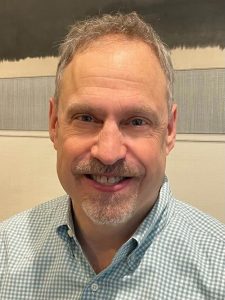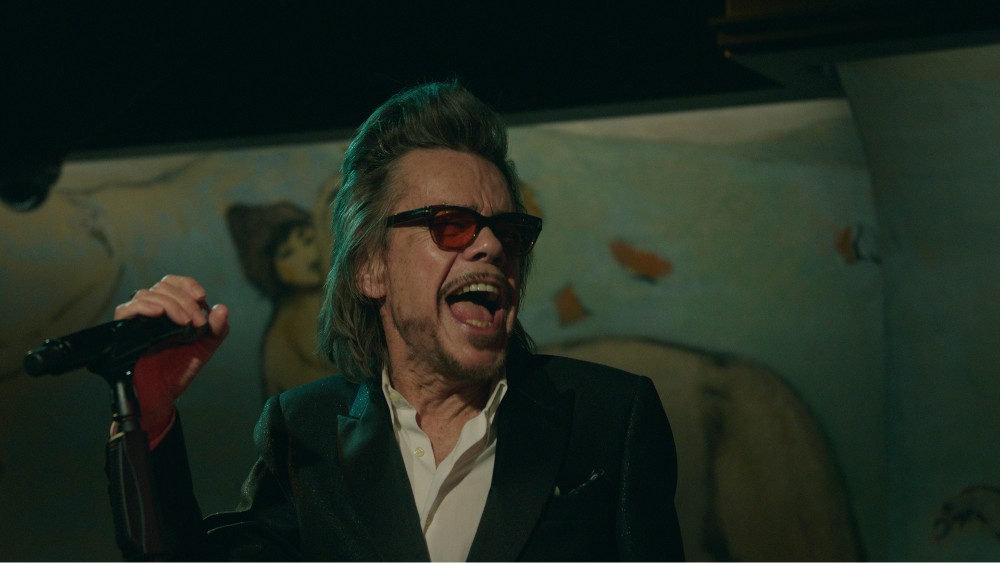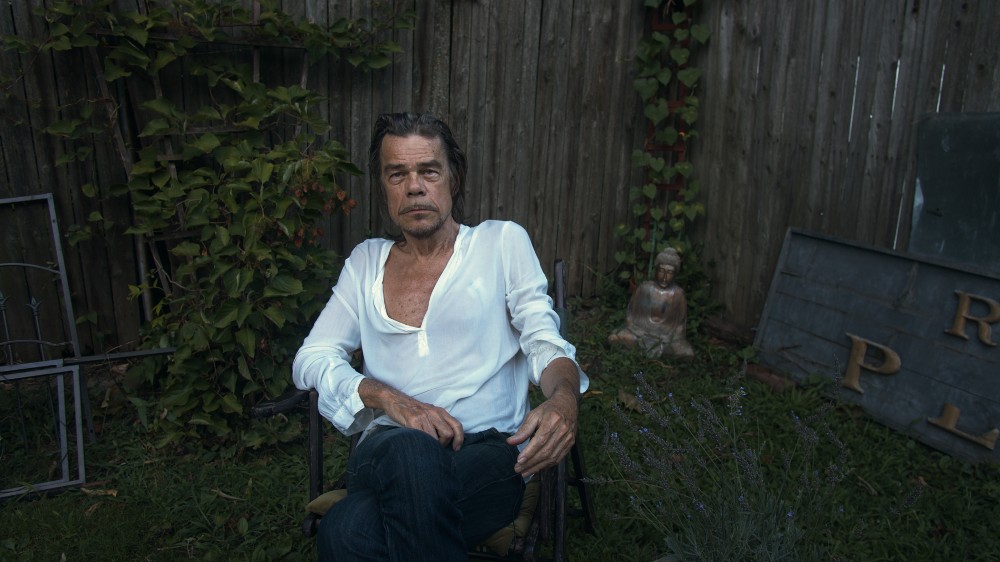Martin Scorsese has regularly drifted from his dramatic work into the documentary world, where he regularly captures live performances by musical artists such as The Band (The Last Waltz), Bob Dylan (No Direction Home), and The Rolling Stones (Shine a Light).
Personality Crisis: One Night Only similarly captures a performance by David Johansen (aka Buster Poindexter) at New York’s Café Carlyle in early January 2020, but it combines that performance with an insightful and comprehensive career profile of the New York Dolls frontman. For those unfamiliar with Poindexter’s previous “day job,” the Dolls are considered to be one of the earliest purveyors of punk rock, along with Iggy Pop and the Stooges (who were similarly profiled in Jim Jarmusch’s Gimme Danger).
Working with Scorsese is his frequent Editor, David Tedeschi, who also co-directed Personality Crisis, which is now streaming via Showtime. Tedeschi is one of the few people on the planet who can say they co-directed a movie with Martin Scorsese not once but twice, and he recently spoke with Below the Line over the phone about what went into capturing Johansen’s performance not knowing that New York City, a mecca for art and performance. would be shut down by the impending pandemic just a few months later.

Below the Line: I think I saw that you first started working with Martin Scorsese on his Rolling Stones concert film, Shine a Light, which you edited… is that correct?
David Tedeschi: Actually, no… longer. We started on The Blues project, but I would date it back to No Direction Home.
BTL: And then you continued working with him, especially on his documentaries and docuseries, and your position has evolved, as you became an EP on a few things. You’re now much more involved with this project as its writer and co-director, so…
Tedeschi: I’m actually not a writer. There’s no writer. I don’t know where that came from. You’re not the only one, by the way. It’s out there. It’s on IMDB or something like that.
I don’t really know how to explain it exactly, but in No Direction Home, we had this wonderful collaboration. I think for Marty, the editor on a documentary is the writer, because you create a structure, and the structure is created also from a feeling — the feeling [of] how you go from one shot to another shot — but it’s a story. It’s very related to what a writer does, I think. As an executive producer on Rolling Thunder, I co-directed The 50-Year Argument, and now I’ve co-directed this. I think it’s just a natural progression of our time together. I don’t know how else to put it. Let’s just say it’s thrilling for me.
BTL: I assume he knew David Johansen and maybe they’d run into each other over the years, but at what point does Marty tell you he’s going to do a movie about him, beginning with his performance at Café Carlyle?
Tedeschi: That’s really how it happened. They were aware of each other for a long, long, long time — decades and decades — and I think they’d met, but I don’t know that they knew each other well. Boardwalk Empire, they worked together, and they really had a simpatico feeling between the two of them. And then, of course, in Vinyl, when the Mercer Arts Center collapses, the Dolls are playing. David re-recorded those songs and their professional friendship continued. David and Mara invited us to show at the Café Carlyle one night, and a bunch of us went, and it was a remarkable show. After the show, Marty and I looked at each other and said, ‘We gotta do something with this. We should film this, we should document this,’ and that was the origin story of this movie
BTL: I sussed out that this was shot in January 2020. I’m not sure if that was towards the end of his run, but he had to stop for a while, obviously, due to COVID shutting everything down. It was good you documented it when you did since no one was performing for a year or more after that.
Tedeschi: Exactly, and that’s the last title card in the end credits is: ‘There was no cabaret, no live theater, no live music indoors in New York City for something like 18 months.’
BTL: What was involved with prepping for the show? Do you generally work with the camera team or does Marty handle that as his thing?
Tedeschi: It’s these long-standing relationships we’ve had over the years. Ellen Kuras and her team shot Personality Crisis. She’s a great DP, she’s worked with us a lot before. She shot the Bob Dylan interview in Rolling Thunder, amongst other things. I don’t know how to say it exactly. A lot of the material that she shot, that made it into the film, was handheld, and I think between the three of us and Margaret Bodde, too, who has produced many of these projects, there’s a shorthand. We have an agreed vision about how to capture music, a certain kind of integrity about cutting, editing. What’s interesting? We like to be funny. I hope we’re funny in this film; I think David’s very entertaining personally.

BTL: I remember hearing or reading about what was involved with making Shine a Line and filming the Stones at the Beacon Theater, so I have to assume this was a somewhat more laid-back shoot?
Tedeschi: I wouldn’t say more laid-back. Shine a Light was 17 35mm cameras, two techno cranes, which was intense, and Bob Richardson did an amazing job. Not just that everything looked really good, but it’s very difficult in a theater that size to fit two techno cranes, and it worked. The techno cranes didn’t hit anybody.
The thing with the Caryle is it’s very small. We shot for two nights — there couldn’t be more than four cameras, and even that was crowded. There wasn’t a lot of space for Ellen to move around, for instance, but the point of the show, the point of the performance for us, largely, was to have an intimate cabaret performance. I hope that’s what we achieved. I think that’s what we achieved. We shot the show. I edited the show, we looked at it, and of course, it loses something in the translation, and our goal was to make a film that felt like this set of David’s that we saw at the Carlyle with the same feeling and energy.
Everything we did was intended to add [to it]. David would tell a story about Charles Ludlum. We might have a piece of Charles Ludlum, a piece of video, audio, photographs. We combined music in unusual ways, but always using the template of his show and the integrity of the show and what the show intended to be, the goal ultimately being to share the same feeling we had, at the end of the first show that we saw that we had no idea what it was going to be.
I had seen David – all of us had seen David many times live. This show was completely different, and I think there are many reasons why it was completely different. His energy was very different. I’ve never seen a show where Buster performed songs written by David Johanssen. It was the first time he did that. But also, he tells the story of his life in between the songs in the setlist. He’s a great storyteller, and I hadn’t realized David had so much to say.
To me, it was very moving, to hear his stories, and for him to capture, at least for me, a feeling of the late 1960s and early 1970s in New York City and how it informed him, how it educated him, how it formed him, and then what he did with it, and how he continued to evolve. He’s a great reader. He’s a connoisseur of music, which you see on [his Sirius] show, Mansion of Fun. He has a wonderful way of combining songs in that setlist, so that was our intention, to recreate the show as best we could, but not simply with what we filmed from the show.
BTL: Does he generally do the same setlist, or does he change it up every night for each show?
Tedeschi: He puts together different shows. This show had the same setlist, maybe it evolved. What we filmed was essentially the same as what I saw with six months between the two, but the stories and stuff are improvised. It’s the same story, but he tells it differently every night. And sometimes he adds a detail, or sometimes he adds another mini-story, but it’s the same show.
BTL: As an editor, it must be nice to be there while it’s being filmed, which is not always the case. Are you there taking notes about what you might cut together later? Or do you just let them shoot it, and you’ll figure it out when you’re back in the edit bay?
Tedeschi: I mean, obviously, we’ve done it both ways. For something like this, where we’re capturing live performance, it was with Marty, and it’s very good to have a sense of what he likes and for us to be communicating there with Ellen Kuras. I was calling the cameras. I had a headphone speaker, and I was talking to the DPs, all of them, so yeah, it’s very helpful to be there while they’re shooting.

BTL: I don’t think I realized Ellen Kuras operated as well.
Tedeschi: She lugs a 40-pound camera like it was five pounds, still. Most of the handheld stuff was her — not all of it, but most of it
BTL: What happens after that? You shot the show, you’re doing other things with Marty, like Pretend It’s a City – I’m not sure where that was at that point — and then COVID hits, and I’m sure you can still edit and do post but it’s probably different than how you might normally work. Were you still editing Pretend It’s a City?
Tedeschi: We were still working on Pretend It’s a City. There’s one point that Netflix put us on hiatus. I was at home. We were not allowed to open the office. Marty and I figured out a way to work on both Pretend It’s a City and Johansson during that period. We looked at dailies. I’d cut a song and show it to him. We would talk about it.
We talked about what needed to be in the film. Are we going to interview people? Are we going to interview David? In fact, David and Mara were very isolated because of COVID, and they weren’t really seeing anybody except their daughter, Leah Hennessy. That’s how it came about that Leah ended up shooting all the interviews, because we were like, “No one can really do this right now. It’s not safe for anyone to do it, but Leah is seeing them anyway. Maybe that would work out.” We talked to her. We gave her questions. She wrote her own questions. She had a real point of view about what she wanted to talk about with David, and she ended up lighting it, shooting it, recording the sound, and asking him the questions. I think she did a phenomenal job.
BTL: Do you and Marty have a system in which you usually work on an edit? I assume he has edit bays at his office, maybe multiple ones or just a main one. Did the two of you have a way of communicating and working remotely?
Tedeschi: We do, but we weren’t allowed in the office. All of the [edit rooms] in New York City were closed. In fact, one of our colleagues went into another office, it was in the West Village, and someone called the police. “Someone’s working in the office!” and they told her that she had to leave. If I remember right, that was three or four months, like March to maybe July, August. I had a system in my house. The Assistant Editor set up the system — he lives maybe 10 blocks from me. When it was legal for us to come in, we started to zip car in, so we wouldn’t have to take the subway. Marty and I — me in my system at home — figured out a system where I could work with him. I could show him things, he could weigh in on things and edit with me. It worked out. If you really want to do something, you’re gonna do it.
BTL: It’s been three years, and it’s still kind of hard to fathom what the city went through during the first few months of the pandemic because no one else had really lived through one since the last one was 100 years ago.
Tedeschi: It was really strange. I live in Park Slope and I take a walk every day at six o’clock, and I had to change my path, because there was a truck by Methodist Hospital, the morgue truck, and I really couldn’t think about that. It was a crazy time in the city.
BTL: What about finding all the other footage? Obviously, the Dolls played on British television, and I assume David had been on American shows as Buster as well. How do you go about finding that stuff? Did he have any of that stuff archived himself?
Tedeschi: Yeah, now I don’t know what’s public and not public. He has stuff, but there are also always collectors, and he has super fans and some of the super fans… like the performance of “Bad Boy” that’s in the movie? That came off VHS tape from one of his collectors, from a superfan. That doesn’t exist anywhere else. It was on a show that Meg Griffin had I think for each one, but there’s no record of it. Meg didn’t have anything, VH1 didn’t have anything. It just existed on that half-inch tape, it’s remarkable. We also had a researcher named Austin Short, who was phenomenal, and there’s a bunch of photographers and filmmakers — Antoine Parrish — who had a lot of stuff of David, of Max’s Kansas City, and that’s remarkable, too. Bob Gruen shot David on one of his solo tours, singing “Frenchette” in Super 8. Of course, it’s in the movie and it really takes you back to that moment. I mean, David, he’s the same person but he’s much younger. And the same as you were saying with The Dolls on national TV singing “Stranded in the Jungle.” We have him beginning “Trash” at Max’s, shot on half-inch reel-to-reel for the portable video. Between the collectors, and David has relationships with most of these photographers, and then Austin’s work, who was a remarkable researcher, I think we turned up some beautiful stuff.
BTL: Definitely. I know the Paley Center is usually a good resource, though I’m not sure that was even open or if anyone was able to go in there.
Tedeschi: They were eventually open, and they are a resource but you have to prove that you’ve licensed something in order for them to give it to you. They don’t necessarily have the best quality — they don’t have two-inch tapes or one-inch tapes. They tend to have formats designed for viewing.
BTL: I know you generally started out editing for television, including Michael Moore’s show. Was there a lot you learned in that period that you were able to bring to your working relationship with Marty?
Tedeschi: Of course. I mean, I worked with Michael Moore, I worked with Barbara Kopple. It was tremendous training for me, in both cases. For me, they’re both great filmmakers, and I learned a lot working with them. I also did a bunch of New York independent narrative films. I worked with Leon Ichaso many times, and it really helped me in terms of learning structure, because we did a film called Piñero, for instance, which is one of the early DV films in the days of InDigEnt Films and Dogme, and it was a film that you have to structure in the edit room. There was a script, but the script was very fragmented, intentionally and beautifully, and along with improvisations, you had to figure out how to do a coherent narrative. With Leon, I also learned a lot, so by the time I got here to Sikelia [Productions, Scorsese’s production company], I had a lot of tools in my toolbox, I’d like to say.
Personality Crisis: One Night Only now streaming via Showtime Anytime.





